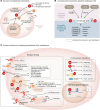The secret life of complement: challenges and opportunities in exploring functions of the complosome in disease
- PMID: 40519170
- PMCID: PMC12165798
- DOI: 10.1172/JCI188350
The secret life of complement: challenges and opportunities in exploring functions of the complosome in disease
Abstract
The complement system is a highly conserved and essential immune component with pivotal roles in innate and adaptive immunity. It is increasingly recognized that the complement system has a profound impact on disease. Current complement-targeting therapeutics for clinical use almost exclusively target the complement system in circulation. However, recent discoveries have demonstrated that complement is not only liver derived and plasma operative, but also synthesized and activated inside many cells locally within tissues, performing noncanonical, cell-autonomous intracellular functions, collectively referred to as the complosome. These intracellular complement pathways are distinct from the classical plasma-based system and critical for regulating fundamental cellular processes, including metabolism, gene transcription, autophagy, and the activation and resolution of inflammation. This Review explores the emerging roles of the complosome and current knowledge regarding its relation to human diseases, highlighting evidence across organ systems and disease states, including the kidneys, digestive tract, lungs, heart, CNS, musculoskeletal system, skin, and cancer. We also review current scientific approaches for detecting and functionally investigating the complosome, addressing challenges such as technological limitations and the need for advanced experimental models to delineate its tissue-specific roles. Finally, we discuss central unanswered questions critical for developing innovative therapeutic strategies targeting intracellular complement pathways. These strategies hold potential to modulate disease-specific mechanisms while preserving systemic complement activity.
Conflict of interest statement
Figures



References
Publication types
MeSH terms
Substances
LinkOut - more resources
Full Text Sources

